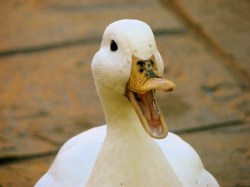“There are few nicer things you can do for your holiday guests,” Anthony Bourdain tells us, “than serve them a delicious terrine of foie gras.” But Bourdain says foie gras lovers should watch out. “Strangely enough, a few twisted, angry people would like to take your foie gras away.”
Full disclosure before I take this any further: While I don’t consider myself particularly “angry” or “twisted” (at least not in the way Bourdain means), I am a vegetarian who opposes cruelty to animals — so much so that I recently exclaimed on a date, in full-on crazy voice, “chickens have families, too!” (Yeah, that guy never called. But for the record: I wasn’t into him, either.) For better or for worse, though, I’m also a total hypocrite: I’m not a vegan and I wear plenty of leather. To be completely honest, every once in a while, after making an embarrassing Portlandia-esque call to a restaurant, I even cave to my fried chicken craving. And before I forswore meat, I enjoyed plenty of it — including foie gras. Five years ago when I went to Paris, I ate it and liked (not loved) it. But I appreciated the novelty enough to smuggle a can home, fry it up, and serve it to my then-boyfriend.
Matters of delectability aside, foie gras lovers face an uphill battle in the quest for kinder meat. Made from the engorged livers of ducks and geese, opponents have been arguing forever that the force-feeding used to enlarge the organ up to eight times its normal size is inherently cruel, not only because of the “gavage” (re: a fancy word for sticking a metal feeding tube down the bird’s throat and pouring grain down the funnel at the top) itself, but also because having a giant, fatty liver causes tons of avian health problems. This was the basis of the lawsuit brought by the Animal Legal Defense Fund against Hudson Valley Foie Gras (HVFG), which ended with HVFG removing its “cruelty-free” and “humane” claims from its advertising and website.
Last month, at the behest of Lawrence W. Bartholf, HVFG hosted a tour of their farm, specifically inviting veterinarians from the Hudson Valley. Originally enlisted by the Sullivan County SPCA more than 30 years ago to accompany them on a raid of the HVFG facility, Bartholf, finding no inhumane conditions, was instead impressed with the facility, especially its regular upgrades. He has since become a vocal supporter of its foie gras production.
As the daughter of the president of the Hudson Valley Veterinary Medical Society (that’s right, my dad is important!), who became a vegetarian not out of a theoretical opposition to eating animals but rather out of a discomfort with the actual practices, I tagged along. Although this gave me some unusual access, almost anyone can arrange a tour — though that “almost” is important: Operations Manager Marcus Henley says only “unbiased” visitors are welcome, specifically excluding PETA affiliates from that category.
The first thing visitors will notice when pulling up to the Ferndale, New York farm is the smell, and it is not one that evokes images of fine dining: It’s the very intense scent of poop. I grew up accompanying my father on farm calls (sometimes for fun, sometimes for punishment), and I don’t remember ever encountering such a powerful stench without even exiting the car. But according to one of the other veterinarians on the tour, someone with far more farm experience than I, the odor was “not that bad, really.” So maybe I’ve just adjusted a little too well to city life.
Once inside the main office, we were introduced to a box of baby ducks, only six days old. After a brief explanation of where baby ducks come from (they’re bred off-grounds), we were taken to the slaughter room. The scene, presumably no different than it would have been if they were raising ducks without producing foie gras, was nothing less than gruesome. The birds are brought in caged, before being hung upside down, stunned, and slit at the throat. Considering they are suspended by their feet, they are surprisingly calm — a result of machinery specifically designed by a former Temple Grandin student to soothe the ducks. (Grandin herself is against gavage.) The ducks in the cages, however, were not so relaxed, and to me, this seemed to be the worst part of the whole process: Watching their brothers (only male ducks are used for foie gras) get slaughtered and beheaded, they must know the same fate awaits them as well, right? Several veterinarians assured me they did not.
But slaughter isn’t the problem animal welfare advocates have with foie gras — it’s what comes before it. After the slaughter room we went back to two separate barns, each housing more than 4,000 ducks. These barns, by all measures, were clean, spacious, and kempt. The birds, one of the veterinarians pointed out, were mostly at ease, exhibiting no visible signs of disease or open sores, and unlike in videos from standard factory farms, there were no dead birds lying around. Food and water were kept on opposite walls, forcing the ducks to exercise. Henley explained that they had tried housing the birds outdoors, but with natural predators lurking nearby, their mortality rate tripled (it’s currently at 5 percent), and the farm even had to hire a full-time trapper. So they brought them back inside.
Once the birds mature, usually between 11 and 13 weeks, however, this carefree existence comes to an end. They begin a three-week course of force-feeding in wire-bottom pens with 10 other birds (a significant upgrade from typical foie gras production practices, in which birds are kept in small, individual cages without room for movement or the comfort of the other birds). Trained feeders start by feeling the bird’s throat to make sure it has digested the last meal. If it hasn’t, he/she marks the bird’s head and moves on to the next. Two skipped meals mean the bird is ready for slaughter. If it is ready for the next meal, the feeder inserts the metal tube into the duck’s throat, pouring a measured amount of food down the funnel, before pulling it out and releasing the bird. The ducks get to know their feeder, which may explain why I only saw one seemingly resisting being caught and fed. At this point, they are all large and most are breathing heavily but they also don’t display any visible sign that they’re in pain.
But just because everything looks fine doesn’t mean it is. According to ALDF testimony from Fern Van Sant, a veterinarian and avian specialist who founded the For The Birds animal hospital, “Veterinarians have historically failed to recognize pain in birds.” Unlike many other animals, whose physical discomfort is often obvious to the casual observer, “birds are naturally stoic prey animals, [and] their demonstration of pain can often go unrecognized.”
While the naked eye may miss signs of pain, forensic analysis, according to the ALDF, does not. An affidavit from veterinary pathologist Robert E. Schmidt points to the serious health problems caused by force-feeding, including various forms of a liver disease known as hepatic lipidosis, which can cause impaired breathing, diarrhea, and eventually death. Testing several foie gras livers from HVFG, veterinary pathologist Schmidt found that all of them came from animals suffering from the condition.
Case closed, right? As Carter Dillard, the litigation director for ALDF, wrote to me, “When faced with having to actually defend their ‘humane’ claims in a court of law, Hudson Valley caved. That speaks for itself.”
Except Bartholf, whose 49-year veterinary practice focuses on livestock but also includes treating “everything but dogs, cats, and ferrets,” flatly rejects the theory that the birds are experiencing physical discomfort. He told me without equivocation, “The enlarged liver is not painful.” The heavy breathing we witnessed is also nothing to worry about says Bartholf, explaining that like dogs, ducks do not sweat — they pant. “That’s just normal,” he says. His assessments are also quoted on the HVFG website, explaining that the ducks’ anatomy makes them particularly suited to gavage. “Unlike that of mammals, the throat of waterfowl is lined with tissue similar to the palm of our hand, permitting them to eat live, wriggling fish, spines and all, without harm, or to accept the feeding tube,” he says. Furthermore, he explains, ducks are not only capable of storing large amounts of food at the base of their throat for later, their livers are also adapted to store extra fat when food is abundant. This makes foie gras almost seem like a natural byproduct of duck physiognomy.”
The veterinarians in the ALDF lawsuit don’t find fault with Bartholf’s anatomy lessons. They agree that ducks will naturally accumulate fat in their livers to store it as energy to be used later. But, as Greg J. Harrison, a specialist in avian medicine, put it, “Commercial production of foie gras has taken advantage of this.”
So who is right — Bartholf or Schmidt, Harrison, and Van Sandt? To help me navigate through this battle of the experts, I consulted with an authority who has guided me through many of life’s quandaries: my father. Currently a small animal practitioner, Alan Shanker has also logged countless hours treating cows, horses, and even the occasional wallaby. Unlike the veterinarians testifying in the ALDF lawsuit, whose C.V.s show expertise mostly in the area of pet birds and zoo animals, my father, while not an avian specialist, comes from a largely agricultural background in veterinary medicine.
After our trip to the farm, I sent him the expert testimony and asked what he made of it. “There’s a health issue, no doubt about that,” he told me. And despite being a regular meat eater, he admitted, “After seeing that [slaughter process], I don’t even want to eat chicken.” (Just to be clear, he will eat it, because that’s what mom’s cooking. Good call on that one, dad.) He was quick to add, though, that in terms of animal cruelty on the farm, he has seen much worse than the force-feeding we witnessed. Dehorning cows, castrating bulls without anesthetic, and raising veal in tiny pens without room to move around are all regular practices that he believes score higher on the inhumanity scale. Had the foie gras been Kosher, he told me, he would have tried it.
The American Veterinary Medical Association’s stance is similarly ambivalent. “It is presumed that under ideal conditions a force-fed duck will not experience injury or liver necrosis,” the organization’s website says. “In the absence of empirical studies,” however, “the welfare of this ideal animal is difficult to judge.”
And yet … and yet. At a recent post-wedding brunch of an equine veterinarian friend, I decided to take a straw poll of the bride’s former classmates from Cornell Veterinary School, several of whom were enjoying sausage and bacon, including one who had made fun of my preference for organic milk, saying it was a waste of money in terms of animal welfare (an entirely different story). Every single veterinarian, including an avian specialist, was unequivocally anti-foie gras. The word “horrifying” was used.
While I commend HVFG for providing its ducks with clean barns, roomy feeding quarters, and well-trained employees, it is hard to escape the basic truth that it is sickening its own animals on purpose and for profit. Especially now that methods for procuring foie gras from goose liver without force-feeding (an innovative method called letting them “feed and live freely”) have been developed, it is hard for an ethical eater to rationalize eating HVFG’s foie gras or anyone else’s that is made with gavage. Even if it is very, very delicious.




